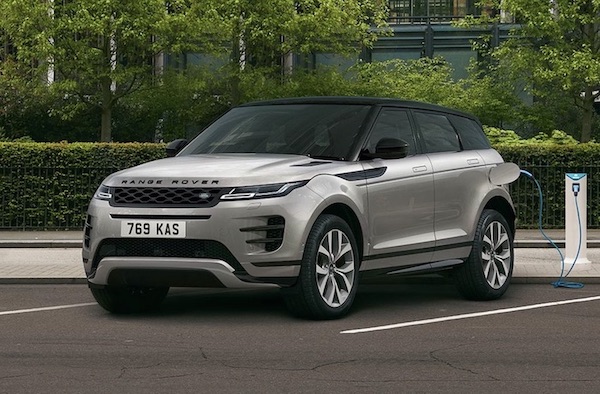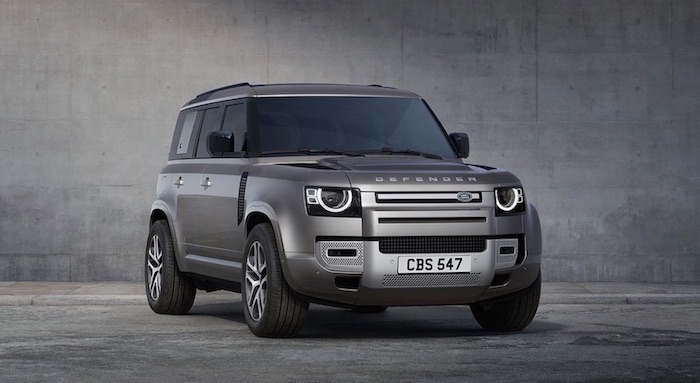Electric Cars: The Basics
For those of you new to zero-emission electric driving, we recommend a read of the following articles:
Sign up to the newsletter
The Jaguar E-PACE PHEV SUV
Jaguar Land Rover (JLR) Automotive PLC is a leading luxury vehicle manufacturer with a distinctive reputation of being British and iconic. However the automotive company is now owned by the leading Indian industrial conglomerate, the Tata Group. The company currently has the following battery-electric vehicles (BEVs) and plug-in electric vehicles (PHEVs):
- Jaguar I-Pace
- Jaguar E-Pace
- Jaguar F-Pace
The conventional compact Jaguar E-PACE SUV was launched in 2017. Since then, Jaguar has also made this compact SUV available as a mild hybrid electric vehicle (MHEV) and a plug-in hybrid electric vehicle (PHEV).
If you like the Jaguar F-PACE PHEV, but are keen on a more ‘affordable’ Jaguar plug-in hybrid SUV, then the Jaguar E-PACE PHEV is worth considering. The shorter wheelbase (2681 mm) P300e AWD Automatic PHEV is markedly cheaper than the F-PACE PHEV.
The all-wheel drive Jaguar E-PACE PHEV has a 15 kWh onboard EV battery, with a WLTP certified emission-free electric range up to 60 km. Though the E-PACE PHEV range is considerably lower than the pure electric Jaguar I-PACE, the claimed 60 km EV range is still useful and helps save money.
2/3rd of motorists drive at an average 50 km or less a day. This should not come as a surprise, as the majority of our commutes are shorter distances. Even assuming a real-world electric range for the E-PACE PHEV closer to 50 km, the EV can be used on a regular basis on the electric mode, which is considerably lower than using petrol or diesel.
Moreover, the use of the EV mode will help improve the overall efficiency of the vehicle. The automotive manufacturer claims a fuel economy up to 2.0 l/100km, but expect the real-world fuel economy to be less efficient. Nevertheless, there is much to gain in improved fuel economy from a PHEV, compared to a conventional petrol or diesel variant.
To achieve the financial savings, charging the onboard EV battery on a regular basis is imperative. The Jaguar plug-in hybrid benefits from DC charging (not all PHEVs do!). You can charge up to 32 kW DC charging at public charging stations: 0% – 80% in 30 minutes. When charging at home, the EV can be charged via a 7 kW dedicated EV charger, overnight (1.4 hours to 80%, 2.2 hours to 100%), when the electricity tariff rates are more attractive.
The E-PACE P300e AWD PHEV combines a 1.5-litre petrol engine with an electric motor. Despite the additional weight of the onboard EV battery, the EV delivers good performance. The E-PACE plug-in achieves 0-100 km/h in 6.1 seconds (maximum power: 309 PS/ maximum torque: 540 Nm). The top speed of the e-SUV is 216 km/h.
Both the exterior and interior of the EV are compelling, completed to a high quality standard and technical specification. In terms of practicality, the boot size of the PHEV is smaller (494 L) than the petrol variant, due to the placement of the onboard EV battery. The headroom for rear seat passengers is limited due to the roofline. Moreover, rear view visibility is also impacted.
There are a host of driver assistance tools as standard, to include: adaptive cruise control, lane keep assist, traffic sign recognition, rear camera, front and rear parking aid etc. Also included as standard are: wireless device charging, wireless Apple CarPlay, voice control, ECO driving style assistant and more.
Jaguar offers a 8 years or 160,000 km warranty and the electric vehicle (EV) has been awarded a Five-Star NCAP Safety Rating. Bottom-line, electric driving is good for the environment and the wallet! The Jaguar PHEV is not available in India.
| PROS | CONS |
|---|---|
| Good looks and exterior styling | Expensive. Cheaper PHEV SUV alternatives available |
| Good infotainment system and high quality interior | Smaller boot space compared to rivals |
| Running on electric mode is cheap | Limited rear view visibility |
The All-Electric Jaguar E-PACE PHEV SUV (credit:JLR)
| At A Glance | |
|---|---|
| EV Type: | Plug-In Hybrid Electric Vehicle (PHEV) |
| Vehicle Type: | SUV |
| Engine: | Electric/ Petrol |
| Available In India: | No |
| Trims (1 Option) |
|---|
| Jaguar E-PACE (from ₹ N/A) |
| EV Battery & Emissions | |
|---|---|
| EV Battery Type: | Lithium-ion |
| EV Battery Capacity: | Available in one battery size: 15 kWh |
| Charging: | 32 kW DC charging: 0-80%: 30 minutes. Onboard charger: 7 kW AC: 1.4 hrs to 80%, 2.2 hrs to 100% |
| Charge Port: | Type 2 |
| EV Cable Type: | Type 2 |
| Tailpipe Emissions: | 44g (CO2/km) |
| Battery Warranty: | 8 years or 160,000 km |
| Charging Times (Overview) | |
|---|---|
| Slow charging AC (3 kW – 3.6 kW): | 6 – 12 hours (dependent on size of EV battery & SOC) |
| Fast charging AC (7 kW – 22 kW): | 3 – 8 hours (dependent on size of EV battery & SoC) |
| Rapid charging AC (43 kW): | 0-80%: 20 mins to 60 mins (dependent on size of EV battery & SoC) |
| Rapid charging DC (50 kW+): | 0-80%: 20 mins to 60 mins (dependent on size of EV battery & SoC) |
| Ultra rapid charging DC (150 kW+): | 0-80% : 20 mins to 40 mins (dependent on size of EV battery & SoC) |
| Tesla Supercharger (120 kW – 250 kW): | 0-80%: up to 25 mins (dependent on size of EV battery & SoC) |
- Note 1: SoC: state of charge
| Dimensions | |
|---|---|
| Height (mm): | 1648 |
| Width (mm): | 2088 |
| Length (mm): | 4395 |
| Wheelbase (mm): | 2681 |
| Turning Circle (m): | 11.63 |
| Boot Space (L): | 494 |
| P300e AWD Automatic PHEV | |
|---|---|
| EV Battery Capacity: | 15 kWh |
| Pure Electric Range (WLTP): | 60 km |
| Electric Energy Consumption (Wh/km): | 209.6 |
| Fuel Consumption (l/100km): | 2.0 |
| Charging: | 32 kW DC charging: 0-80%: 30 minutes. Onboard charger: 7 kW AC: 1.4 hrs to 80%, 2.2 hrs to 100% |
| Top Speed: | 216 km/h |
| 0-100 km/h: | 6.1 seconds |
| Drive: | All-wheel drive (AWD) |
| Electric Motor (kW): | 80 |
| Max Power (PS): | 309 |
| Torque (Nm): | 540 |
| Transmission: | Automatic |
| Seats: | 5 |
| Doors: | 5 |
| Unladen Weight-EU (kg): | 2,173 |
| Colours: | 12 |
| NCAP Safety Rating: | Five-Star |
Types Of Electric Vehicles (EVs)
“Electric vehicle” is an umbrella term, and a broad one at that. There are a number of different types of electric vehicles (EVs), each with its distinct characteristics and advantages. These include:
- BEVs: Battery-electric vehicles (pure electric)
- PHEVs: Plug-in hybrid electric vehicles (electric and internal combustion engine (ICE) combined)
- MHEVs: Mild hybrid electric vehicles (internal combustion engine (gasoline or diesel) along with regenerative braking)
- FCEVs: Fuel cell electric vehicle (electric with hydrogen as fuel)
The above “types” are powered either entirely or partially by electric energy and have different environmental impacts.
Battery-Electric Vehicles (BEVs)
Battery-electric vehicles (BEVs), also known as pure electric vehicles, are powered entirely by electricity (i.e. the vehicle does not have a conventional internal combustion engine). BEVs have zero-tailpipe emissions and help improve local air quality.
BEVs are also very economical to drive. A BEV can cost as little as Rs 50 per 100 kilometres to drive. Examples of best-selling EVs include, the all-electric Tesla Model 3 and the all-electric Renault Zoe. A BEV is charged by plugging in the electric vehicle to a dedicated electric car charging station (home or public charging stations). BEVs are well suited for those living in towns, cities and urban centres. Of course, battery-electric vehicles are also suitable for those living in rural settings.
Plug-In Hybrid Electric Vehicles (PHEVs)
Plug-in hybrid electric vehicles (PHEVs) differ from battery-electric vehicles (BEVs), in that, PHEVs use both a conventional internal combustion engine (ICE) and an electric engine for propulsion. Plug-in hybrid vehicles combine the advantages of electric driving and internal combustion engine driving.
On shorter distances, the PHEV uses the electric mode to drive emission-free, using the on-board EV battery and regenerative braking. For longer distances, the plug-in hybrid electric vehicles switches to using the internal combustion engine. With a PHEV, the vehicle can cost as little Rs 50 per 100 kilometres to drive on e-mode, without any tailpipe pollution, and also be driven long-distances, without the fear of range anxiety! Most PHEVs have an EV battery of up to 15 kWh and can achieve a zero-emission electric range of up to 50 kilometres. No wonder PHEVs are fast becoming popular globally, with much potential or India. Like a BEV, the plug-in hybrid electric vehicle is charged by using an external power source (EV charging point) for charging.
PHEVs are suitable for those that drive long-distances on a regular basis but want to lower the negative environmental impact from tailpipe pollution. PHEVs are also suitable for those individuals and families that are seeking to save money by taking advantage of electric driving. The Volvo XC40 PHEV and the Volkswagen Golf 8 are good examples of PHEVs.
Mild Hybrid Electric Vehicles (MHEVs)
Mild hybrid electric vehicles (MHEVs) are a limited form of electric driving. These vehicles also use hybrid technologies (electric driving and internal combustion engine), but the EV battery is much smaller than a BEV or PHEV. Moreover, in a mild hybrid, the EV battery cannot be charged via an external source (i.e. EV charging station). In a MHEV, the battery is charged by capturing the energy released during braking, a process known as regenerative braking. MHEVs have lower tailpipe emissions, and are more economical to own, run and maintain than petrol and diesel cars. MHEVs are a better option than a petrol or diesel car, but not as good an option as a BEV or PHEV. Mild hybrids are well suited for those living in regions with limited charging infrastructure. Again, MHEVs have great potential in India, given the limited public EV charging infrastructure.
The Toyota Prius is a good example of a mild hybrid electric vehicle.
Fuel Cell Electric Vehicles (FCEVs)
Fuel Cell Electric Vehicles (FCEVs) also called hydrogen fuel cell vehicles, have a fuel cell stack that uses hydrogen to generate the electricity needed to power the electric vehicle. The fuel cell generates electricity and pure water vapour that can escape via the tailpipe. It is capable of generating electricity as long as there is a steady supply of hydrogen. Fuel cell electric vehicles can be refuelled with hydrogen at purpose built filling stations. Filling an FEC takes no more than five minutes.
FCEVs have a range of about 500 kilometers or more between refueling. Today, the only and major limitation is the very limited hydrogen refuelling station network globally. The Toyota Mirai FCEV is a good example of this type of EV.
While e-zoomed uses reasonable efforts to provide accurate and up-to-date information, some of the information provided is gathered from third parties and has not been independently verified by e-zoomed. While the information from the third party sources is believed to be reliable, no warranty, express or implied, is made by e-zoomed regarding the accuracy, adequacy, completeness, legality, reliability or usefulness of any information. This disclaimer applies to both isolated and aggregate uses of this information.

































